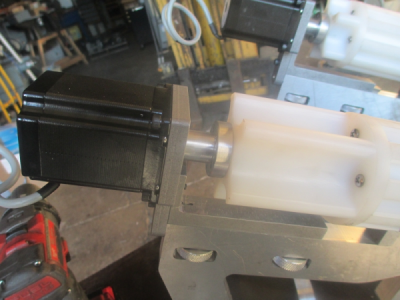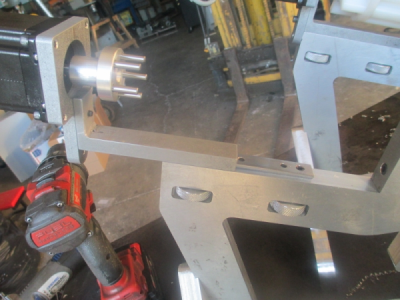-
Welcome back Guest! Did you know you can mentor other members here at H-M? If not, please check out our Relaunch of Hobby Machinist Mentoring Program!
You are using an out of date browser. It may not display this or other websites correctly.
You should upgrade or use an alternative browser.
You should upgrade or use an alternative browser.
B
Bill Gruby
Forum Guest
Register Today
Interesting, yes, Improvements, absolutely. When you read it all the bad points will jump fight out at you. LOL The concept is a valid one, it just falls too short in quite a few places. The biggest design flaw is it's size. A 4X7 chuck doesn't cut it in my book. The change to 5X10 chuck will triple its usage.
"Billy G"
"Billy G"
- Joined
- Dec 16, 2014
- Messages
- 5
Magnetic Chuck is here with the parallels and Vee Blocks. Just beautiful. Yes this is Billy G, something is amiss with my regular account. I had to get a new computer as the hard drive went this morning along with the MB. Once all that goes it is too expensive to rebuild.
"Billy G"
"Billy G"
B
Bill Gruby
Forum Guest
Register Today
All set now.
"Billy G"
"Billy G"
- Joined
- Feb 8, 2014
- Messages
- 11,144
I had a chance to look over the original article. At first glance, as you said, there are a few things that jump out that could be done differently/made better.
The linear bearing rails don't seem the be the best system for a surface grinder. The grit has a good chance of getting into the bearings and destroying them in short order. Ball bearing V-rails would be a better choice IMHO. Easy to clean, and allows the table to be lifted off for maintenance.
The main frame seems a bit light at 0.250 thick. 0.750 thick would be my choice, but I tend to overbuild (and I have forklifts)
The table ''drive'' system seems to be a bit lacking, a more conventional system might work better. A rack & pinion or a timing belt drive might be a better choice.
Powering the table was mentioned above, I would use a stepper motor and a cheap pulse generator to run it. Provide a quick disconnect for the motor for manual use. I designed a zero lash quick disconnect for a stepper that works very well. I'll pass that along if you want to go that route.
I'll have more once I have had a chance to study the drawings for a bit. Time to go make chips now.
.
.
The linear bearing rails don't seem the be the best system for a surface grinder. The grit has a good chance of getting into the bearings and destroying them in short order. Ball bearing V-rails would be a better choice IMHO. Easy to clean, and allows the table to be lifted off for maintenance.
The main frame seems a bit light at 0.250 thick. 0.750 thick would be my choice, but I tend to overbuild (and I have forklifts)
The table ''drive'' system seems to be a bit lacking, a more conventional system might work better. A rack & pinion or a timing belt drive might be a better choice.
Powering the table was mentioned above, I would use a stepper motor and a cheap pulse generator to run it. Provide a quick disconnect for the motor for manual use. I designed a zero lash quick disconnect for a stepper that works very well. I'll pass that along if you want to go that route.
I'll have more once I have had a chance to study the drawings for a bit. Time to go make chips now.
.
.
B
Bill Gruby
Forum Guest
Register Today
Hi Jim:
Still working on the Table system. Jury is still out. I like the V-Way. Table movement at this point is to be rack and pinion, 10 pitch
Metal will be A36 1/2 inch thick.
I would like to hear more on the power feed if you can spare the tine.
"Billy G"
Still working on the Table system. Jury is still out. I like the V-Way. Table movement at this point is to be rack and pinion, 10 pitch
Metal will be A36 1/2 inch thick.
I would like to hear more on the power feed if you can spare the tine.
"Billy G"
B
Bill Gruby
Forum Guest
Register Today
OK update for all -- Rack and pinion is here. Mag Chuck is here. Waiting on the motors but that will take a little more time. That is Marks' job. I know very little in that area.. Steel has been ordered. The steel is the biggest expense so far. We will not be cutting any corners on this project.
"Billy G and Mark"
As soon as we get the camera set up in the new computer, pictures will follow.
"Billy G and Mark"
As soon as we get the camera set up in the new computer, pictures will follow.
- Joined
- Feb 8, 2014
- Messages
- 11,144
The reason I suggest a stepper motor is that they are easy to set up and cheap, with lot's of low speed torque. One of the problems with home brew power feeds is the start and stop at the end of travel. If the motor is instantly reversed at the end of travel things get ugly in a hurry. You want the table to decelerate smoothly to a stop before reversing direction and accelerating smoothly to speed again.
This is the ideal motion profile where the table reaches the set speed just before the wheel touches the work and starts the decel just after the wheel clears the work.

The Constant Velocity distance is set with table stops that hit a limit switch(s)
I will play with the stepper pulse generator (about $10 from ebay) that I have here to see if I can get the motion profile to work correctly. Right now it's pretty much on or off. If that fails, there are other options I can look at.
It would be possible to accomplish this with a DC motor by simply turning it off, allowing it to coast to a stop, before reversing direction. But there is still the issue of acceleration, so some provision would have to be provided for controlled acceleration. Many DC controllers have this provision.
Here are a couple of pictures of the zero lash quick disconnect that I designed for a drive system. This was designed so the machine operator could change out the plastic drum for different products very easily. But it is also adaptable for many drive systems.

The drive consists of five 3/16 dowel pins that engage with the five reamed holes in the UHMW drum. Due to the springiness of the UHMW, the reamed holes are slightly undersize but allow easy insertion of the dowel pins. The motor mount slides on a dovetail that is tightened with the two thumb nuts below.

If the UHMW socket was anchored to the table drive shaft, it would drive it just fine. The torque is not an issue, I built something like this many years ago that was 4 inch diameter and an inch thick out of UHMW for my boat drive shaft. It transmitted 300 HP for years with no problem.
.
.




This is the ideal motion profile where the table reaches the set speed just before the wheel touches the work and starts the decel just after the wheel clears the work.

The Constant Velocity distance is set with table stops that hit a limit switch(s)
I will play with the stepper pulse generator (about $10 from ebay) that I have here to see if I can get the motion profile to work correctly. Right now it's pretty much on or off. If that fails, there are other options I can look at.
It would be possible to accomplish this with a DC motor by simply turning it off, allowing it to coast to a stop, before reversing direction. But there is still the issue of acceleration, so some provision would have to be provided for controlled acceleration. Many DC controllers have this provision.
Here are a couple of pictures of the zero lash quick disconnect that I designed for a drive system. This was designed so the machine operator could change out the plastic drum for different products very easily. But it is also adaptable for many drive systems.

The drive consists of five 3/16 dowel pins that engage with the five reamed holes in the UHMW drum. Due to the springiness of the UHMW, the reamed holes are slightly undersize but allow easy insertion of the dowel pins. The motor mount slides on a dovetail that is tightened with the two thumb nuts below.

If the UHMW socket was anchored to the table drive shaft, it would drive it just fine. The torque is not an issue, I built something like this many years ago that was 4 inch diameter and an inch thick out of UHMW for my boat drive shaft. It transmitted 300 HP for years with no problem.
.
.




B
Bill Gruby
Forum Guest
Register Today
Thank you Jim, keep us posted and I will also work on it here.
"Billy G"
"Billy G"

